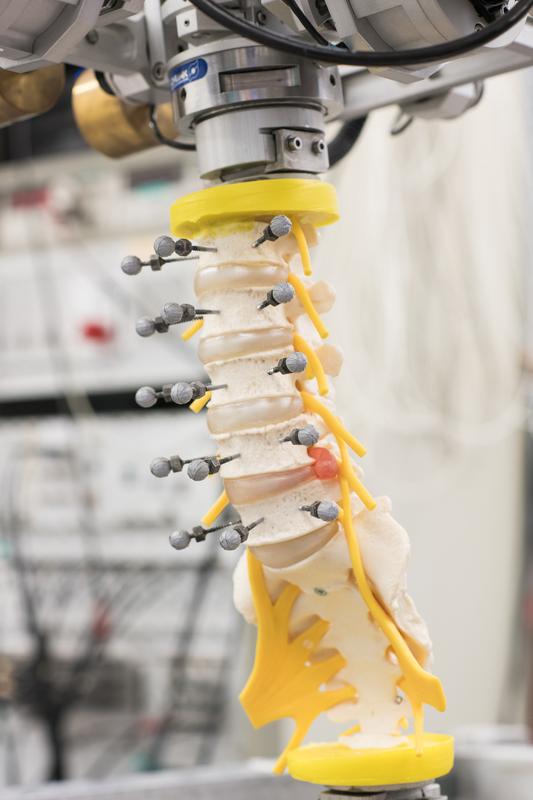
Spinal disc under scrutiny – EU project 'iPSpine': One million euros for researchers in Ulm

Model of a human spine with a synthetic intervertebral disc
Foto: Elvira Eberhardt / Uni Ulm
Back pain is one of the leading causes for disability around the world. In the European Union alone, the economic costs of lower back pain (LBP) amounts to more than 240 billion euros annually. The most common cause of this type of pain: degenerated intervertebral discs.
With a total of 15 million euros for five years, the European Union is funding a major European project which is radically breaking new ground in the treatment of degenerative disc disease. The 'iPSpine' project, coordinated by Utrecht University, combines innovative biomaterials with stem cell-based approaches.
Among the 20 project partners are Ulm University and its spin-off company SpineServ, which will jointly receive close to one million euros. Their mission: to develop hardware and software to put natural and artificial disc material to the test.
In the iPSine project, the scientists from Ulm set out to investigate the biomechanical properties of these novel material-cell combinations. 'Can the stability of the intervertebral disc be restored with these new composites? How does the treated disc cope with long-term stress, how does it react to intense complex strains?', are some of the questions which Professor Hans-Joachim Wilke will address with Ulm's part of the project.
The scientist conducts research on the basic functions and load limits of the spine at the Institute of Orthopaedic Research and Biomechanics. 25 years ago, Wilke developed a spinal loading simulator to systematically investigate the functional principles and load limits of the spine and its components.
The device's services are in great demand internationally since it is to this day one of the world's leading instruments. The researchers in Ulm are currently developing a mobile version that is easier to transport and can be used in the iPSpine partner laboratories, for the test material – which includes both natural and 'artificial' disc tissue – is highly sensitive.
In a second part of the project, the company SpineServ, a spin-off of Wilke's research group, is developing specialised software to better measure disc-related de- and regeneration processes. The goal is to use artificial intelligence to determine the degree of degeneration in follow up studies.
By quantifying the loss of material, a measurement method will then be developed that will in turn make it possible to record the regeneration of disc tissue and to visualise even minimal effects.
And, what exactly are those material compounds that are being investigated and tested within the European iPSpine consortium. “The advanced therapeutic approach entails the use of Pluripotent Stem cells (iPS) combined with smart biomaterials that mimic the healthy disc environment,” informs iPSpine coordinator Marianna Tryfonidou, Professor of Regenerative Orthopaedics at Utrecht University, Faculty of Veterinary Medicine.
These are intended to promote and support the growth of the transplanted cells and rejuvenate the degenerated disc. The scientific spectrum ranges from basic research to preclinical testing to therapeutic use in the clinic.
The research results not only help humans to better treat degenerative disc diseases. In the context of clinical studies, they also directly benefit diseased animals. The first to benefit, for instance, will be certain breeds of dachshunds, which are also back pain patients since they frequently suffer from painful herniated discs as a consequence of their excessively long spine.
The intervertebral disc is a marvel of nature
In order to therapeutically maintain the functionality of the spine, it is essential to understand the structure and function of its components. The iPSpine researchers are placing a particular focus on intervertebral discs. 'The intervertebral disc is one of nature's great marvels,' enthuses Professor Hans-Joachim Wilke.
The spinal discs, so the alternative term, connect the vertebral bodies. They ensure the mobility of the spine and at the same time serve as shock absorbers. 'The intervertebral disc is designed perfectly. On the outside, it is surrounded by a so-called anulus fibrous ring made of complex collagen fibre structures.
On the inside, there is a core called nucleus which consist of malleable gelatinous material that can absorb kinetic energy like a water cushion,' the scientist explains. But what happens when the disc degenerates more and more? Massive pain and discomfort can be the result.
Sometimes it is age-related diseases, sometimes excessive work-related loading or genetic factors that badger the spinal discs. 'Imagine an old car tyre that has lost some air and has also become brittle and worn-out over time,” says Wilke. Similar to a car tyre, the fibre ring around an intervertebral disc is composed of many layers of intersecting fibre structures.
These have inverse angles of inclination and provide stability for a wide range of rotational movements. When the fibre ring is injured, parts of the gelatinous core can leak out and press on the nerves. When that is the case, doctors colloquially speak of a herniated disc. This is often extremely painful and leads to a drawn-out impairment of the spine. It is also one of the most serious events related to the lower back.
Together with their 19 project partners from 7 European countries as well as the USA and Hong Kong, Ulm's researchers are investigating how degenerated discs can be regenerated.
Text: Andrea Weber-Tuckermann
Translation: Dani Wittmeier
Prof. Dr. Hans-Joachim Wilke, Institute of Orthopaedic Research and Biomechanics, University Medical Centre Ulm, phone: +49 731 500 -55320, email: hans-joachim.wilke@uni-ulm.de
Information online: www.ipspine.eu












